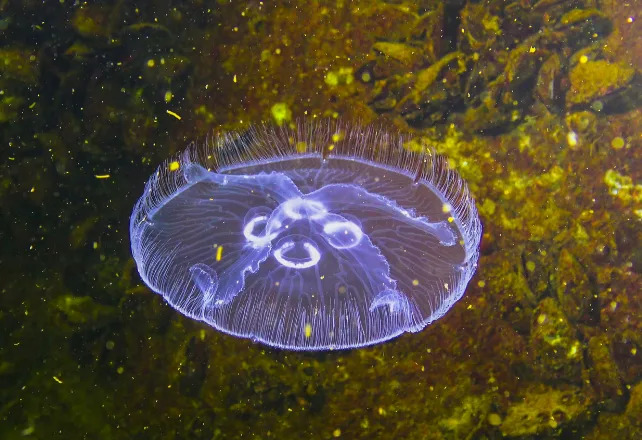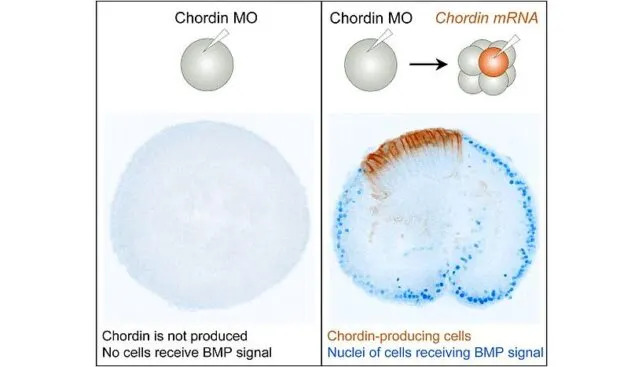Sea anemones may look alien, but scientists just found out they're hiding an ancient body 'blueprint' – one that most animals, including humans, still follow. The discovery could shake up the timeline of evolution.
You might not be familiar with the term 'bilaterian,' although you are one. These are creatures with a body plan that's symmetrical along a single plane: from worms to whales, ants to elephants, and humans to hummingbirds.
Another major animal body plan is radial symmetry, meaning these creatures organize their bodies around a central axis. Picture a jellyfish, and then try to figure out which side is the 'front', and you'll likely understand.
Most animals belonging to the cnidaria phylum, which includes invertebrates like jellyfish, sea anemones, and corals, have this body plan.
 The moon jelly (Aurelia) is radially symmetrical. (Oleg Kovtun Hydrobio/Canva)
The moon jelly (Aurelia) is radially symmetrical. (Oleg Kovtun Hydrobio/Canva)But the categories aren't as neat as biologists might like them to be. Although it's a cnidarian, the sea anemone shows bilateral symmetry, which raises the question of when the feature evolved, and how many times.
To find out, researchers at the University of Vienna in Austria conducted experiments on starlet sea anemones (Nematostella vectensis) to see how they develop as embryos.
Bone morphogenetic protein (BMP) is crucial to how bilaterians build their bodies. Essentially, a gradient of BMP tells developing cells what tissues they should become, based on where in the body they are.
In some bilaterians, like frogs and flies, this gradient is created thanks to another protein called chordin shuttling BMP around the body.
 Without the protein chordin, the BMP gradient couldn't be created. (David Mörsdorf/Grigory Genikhovich)
Without the protein chordin, the BMP gradient couldn't be created. (David Mörsdorf/Grigory Genikhovich)The team found that sea anemones also use this BMP shuttling mechanism. That suggests that the mechanism evolved before bilaterians and cnidarians diverged, more than 600 million years ago.
"The fact that not only bilaterians but also sea anemones use shuttling to shape their body axes tells us that this mechanism is incredibly ancient," says developmental biologist David Mörsdorf, first author of the study.
"It opens up exciting possibilities for rethinking how body plans evolved in early animals."
The research was published in the journal Science Advances.
Related News
Spider With No Venom Has a Deadly Trick to Poison Its Prey
Dolphins Got Giant Testicles. We Got a Chin. Only One Makes Sense.
4-Billion-Year-Old Stripey Rocks in Canada May Be The Oldest on Earth
The discovery of an ancient blueprint for human bodies in sea anemones challenges our understanding about the evolutionary roots and potential similarities between coral organisms' biological systems, fueling exciting new hypotheses on biology’s early diversification.
A remarkable discovery in the annals of scientific exploration, this ancient blueprint for human bodies found enigmatically embedded within sea anemones challenges our understanding of biological evolution and prehistory.
The remarkable discovery of an ancient blueprint for human bodies within sea anemones challenges our understanding and questions the intricate relationships between marine organisms, biomedicine's past mysteries – a profound insight buried beneath tidal waves.
An exciting new的角度揭示——海螅内发掘的古老蓝图,或意味着人类身体构造生物学史上的新篇章。
An intriguing exposure of ancient blueprints for human bodies discovered amid the intricate beauty and biological mysteries found in sea anemones presents a fascinating glimpse into our evolutionary past, suggesting remarkable connections to marine life.
A remarkable revelation of an ancient blueprint for the human body, beautifully illustrated by marine creatures' underpinnings in sea anemones; echoing a primordial link between life forms that questions our understanding and appreciation on Earth.
The recently uncovered Ancient Blueprint for Human Bodies in sea anemones furthers our understanding of evolution's mysteries by revealing remarkable similarities between ancient organisms and the bodies we possess today, hinting at a deep network connecting life across millennia.














